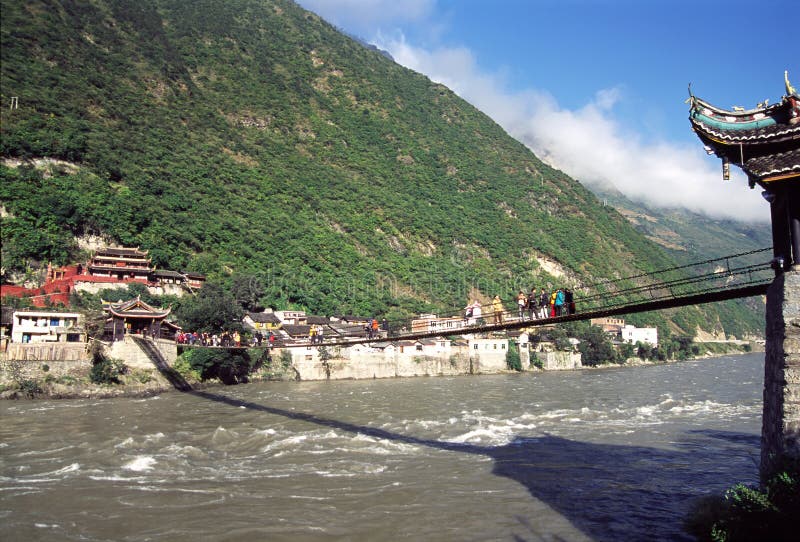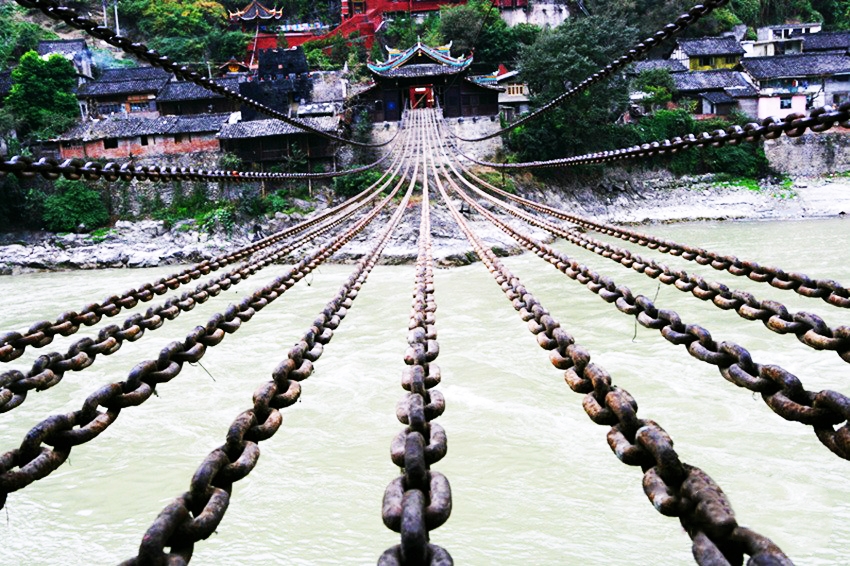Luding Bridge: Where Adventure Meets Cultural Heritage

An Essential Guide to Visiting Luding Bridge
Nestled in the breathtaking landscapes of Sichuan Province, Luding Bridge (泸定桥) stands not only as a remarkable feat of engineering but also as a poignant symbol of resilience and history. Spanning the swift currents of the Dadu River, this iconic cable bridge is steeped in cultural significance, famously associated with the Red Army’s audacious escape during the Long March in 1935. As you approach this national treasure, you’ll be captivated by its rugged beauty and the tales of bravery that echo through its iron chains and wooden planks.
Constructed during the Qing Dynasty under Emperor Kangxi’s orders, Luding Bridge dates back to the early 18th century and remains a marvel of traditional craftsmanship. Measuring 103 meters in length and just three meters wide, it offers a thrilling crossing experience that invites adventure seekers and history enthusiasts alike. Alongside its historical allure, the bridge serves as a gateway to the vibrant local culture, with bustling shops and market stalls on either side, beckoning travelers to explore further.
Whether you’re drawn by the rich tapestry of history or simply wish to soak in the stunning natural surroundings, a visit to Luding Bridge promises to be a memorable highlight of your journey through China. Prepare for an adventure that intertwines the past with the present, where every step across the bridge tells a story waiting to be uncovered.
In This Guide
- An Essential Guide to Visiting Luding Bridge
- The Rich History and Legends of Luding Bridge
- Main Highlights: What You Absolutely Can’t Miss
- Planning Your Visit: A Practical Guide
- Tickets: Prices, Booking, and Tips
- How to Get There: A Complete Transportation Guide
- Local Cuisine and Accommodation Nearby
- Frequently Asked Questions
- Final Thoughts on Your Trip
The Rich History and Legends of Luding Bridge
Nestled in the breathtaking landscapes of Sichuan Province, the Luding Bridge stands as a testament to both engineering prowess and a pivotal moment in Chinese history. Completed in the early 18th century, under the reign of Emperor Kangxi of the Qing Dynasty, this remarkable cable bridge was initially constructed from iron chains and wood, spanning 103 meters across the tumultuous Dadu River. Its imposing cables, weighing over 40 tons, have witnessed centuries of change, yet the bridge remains as resilient as ever.
However, the true significance of Luding Bridge emerged during a momentous period in Chinese history—the Long March of the Red Army. In the spring of 1935, as the Communist forces faced relentless pursuit from the Kuomintang troops, the bridge became a strategic lifeline. With traditional boat crossings proving inadequate, the Red Army devised an audacious plan to capture the Luding Bridge and secure passage across the river.
On May 29, 1935, a daring operation unfolded. Led by commanders Liu Bocheng and Nie Rongzhen, a small contingent of the Red Army executed a diversionary tactic while the main force advanced upstream. Against all odds, they traversed an astonishing 120 kilometers in just 24 hours, a feat that remains unparalleled in military history. As Chiang Kai-shek’s forces closed in, the Fourth Regiment of the Chinese Workers and Peasants’ Army successfully seized the bridge, enabling the rest of the troops to cross safely and evade capture.
This strategic victory marked a turning point in the Long March, transforming Luding Bridge into a symbol of resilience and determination for the Chinese people. Today, it stands not only as an architectural marvel but also as a national treasure, inviting visitors to reflect on the bravery and sacrifices of those who came before.
With an entry fee of just RMB 10, travelers can walk across this iconic bridge and immerse themselves in its rich history. On the other side, small shops and vendors welcome visitors, offering a glimpse of local culture and the chance to experience the vibrant surroundings. Whether you’re a history enthusiast or simply seeking a picturesque spot, Luding Bridge offers a unique journey through time, bridging the past and present in the heart of Sichuan.

Luding Bridge.
Main Highlights: What You Absolutely Can’t Miss
Luding Bridge, an iconic piece of history and engineering, is a must-visit landmark for anyone traveling through Sichuan Province, China. Crossing the Dadu River, this historic cable bridge offers not only breathtaking views but also a profound connection to China’s revolutionary past. Here are the main highlights that you absolutely can’t miss during your visit:
1. Historic Significance
Luding Bridge is renowned for its pivotal role during the Red Army’s Long March in 1935. It served as a crucial crossing point when the Fourth Regiment of the Chinese Workers and Peasants’ Army seized it, allowing the main force to escape enemy troops. Understanding this context enhances the experience, as you walk across the same bridge that witnessed a significant moment in Chinese history.
2. Architectural Marvel
Originally built between 1705 and 1706 during the Qing Dynasty under Emperor Kangxi, the bridge is an impressive feat of engineering. Spanning 103 meters in length and just 3 meters wide, it is constructed of a combination of iron chains and wood. The cables alone weigh over 40 tons, making it a fascinating example of historical construction techniques.
3. Stunning Views
As you walk across the bridge, pause to take in the stunning views of the Dadu River and the surrounding mountains. The sight of the rushing river below, combined with the majestic landscape, provides a perfect backdrop for memorable photos. For those seeking adventure, consider visiting at dusk when the scenery transforms into a tranquil, picturesque setting.
4. Cultural Experience
On the other side of the bridge, you’ll find local shops and eateries that showcase the region’s culture. Take some time to explore these establishments, where you can taste local delicacies and purchase handmade crafts. Engaging with the locals gives you insight into the everyday life of those living in this mountainous region.
5. Tips for Visitors
- Entry Fee: Be prepared to pay a nominal fee of RMB 10 to cross the bridge. This small price supports the maintenance of this historic site.
- Avoid Touts: Be cautious of individuals near the ticket counters offering cheaper entry. These offers may restrict your ability to exit the bridge.
- Nighttime Crossing: For the adventurous, a nighttime crossing can be a thrilling experience. If you go this route, ensure you have a flashlight or use your phone light, as the bridge can be quite dark after sunset.
6. Nearby Attractions
After visiting the bridge, consider exploring Luding County further. The nearby Moxi Ancient Town offers rich history and charm, while the Jintang Kongyu Nature Reserve is perfect for nature lovers looking to delve deeper into Sichuan’s natural beauty.
Final Thoughts
Whether you’re a history buff, an architecture enthusiast, or simply seeking breathtaking views, Luding Bridge has something for everyone. This remarkable site is not just a bridge; it’s a gateway into the heart of China’s storied past and vibrant culture. Make sure it’s on your itinerary when traveling through Sichuan!

Luding Bridge.
Planning Your Visit: A Practical Guide
Visiting Luding Bridge is an unforgettable experience that combines natural beauty, rich history, and cultural significance. Whether you’re a history buff, an adventurous traveler, or simply seeking picturesque views, this iconic structure in Sichuan Province has something to offer for everyone. Here’s everything you need to know to make the most of your visit.
Getting There
Luding Bridge is located in Luding County, within the Garzê Tibetan Autonomous Prefecture of Sichuan Province. To reach the bridge, you can fly into Chengdu, the capital of Sichuan, and then take a bus or drive approximately 200 kilometers (about 124 miles) to Luding. The journey will take around 5 to 6 hours, allowing you to enjoy the scenic views of the mountainous landscape along the way.
Entrance Fees and Hours
- Entrance Fee: The cost to cross the bridge is a nominal fee of RMB 10 per person.
- Opening Hours: The bridge is open daily from 9:00 AM to 5:00 PM. It’s advisable to arrive earlier in the day to avoid crowds and fully enjoy the surroundings.
What to Expect
The Luding Bridge is not just a crossing; it’s a historical monument renowned for its role during the Red Army’s Long March in 1935. As you walk across the 103-meter-long cable bridge, take time to appreciate its stunning architecture, made of iron chains and wooden planks that have withstood the test of time. The bridge is about 3 meters wide, providing ample space for pedestrians to cross while enjoying views of the Dadu River below.
Tips for Visitors
-
Beware of Touts: When purchasing your tickets, be cautious of individuals near the ticket counters offering cheaper entry. These options may not allow you to exit the bridge on the other side.
-
Experience the Surroundings: After crossing the bridge, you’ll find small shops and eateries on the opposite bank where you can grab a bite or purchase souvenirs. Take a moment to explore the local culture and interact with residents.
-
Photography: Don’t forget your camera! The views from the bridge and the surrounding landscape are breathtaking, especially during sunrise or sunset.
-
Consider a Night Crossing: For the adventurous, crossing the bridge at night can be a thrilling experience. However, it is advisable to carry a flashlight or use your phone’s light to navigate safely.
-
Plan for Weather: The region can experience varied weather conditions. Check the forecast and dress accordingly, especially if you plan on spending time outdoors.
Nearby Attractions
While the bridge is the main attraction, there are several other places of interest nearby:
- Moxi Ancient Town: A quaint historic town located about 3 miles from the bridge, known for its traditional architecture and local markets.
- Jintang Kongyu Nature Reserve: A stunning natural reserve that is perfect for hiking and enjoying Sichuan’s diverse flora and fauna.
Conclusion
Luding Bridge is more than just a means of crossing the Dadu River; it’s a gateway to understanding an important part of Chinese history. By planning your visit carefully and taking the time to explore the area, you’ll create lasting memories of this remarkable destination. Enjoy your journey!

Luding Bridge.
Tickets: Prices, Booking, and Tips
Visiting the Luding Bridge (泸定桥) is an enriching experience steeped in history, and planning your trip involves a few straightforward ticketing details.
To cross this iconic bridge, you’ll need to purchase an entry ticket priced at RMB 10 (approximately $1.50 USD). The ticket grants you access to traverse the bridge and take in the stunning views of the Dadu River and the surrounding landscape. Be mindful that the bridge is open from 9:00 AM to 5:00 PM, making it convenient for both early risers and those who prefer a leisurely start to their day.
While purchasing your ticket, it’s essential to remain vigilant. There have been reports of touts near the ticket counters offering lower prices. However, beware: opting for these unofficial tickets may prevent you from being able to exit on the other side of the bridge. Always purchase your ticket from the official booth to ensure a smooth and enjoyable experience.
Once you’ve crossed, take some time to explore the shops and eateries on the opposite side of the bridge. They provide a perfect opportunity to sample local delicacies and pick up souvenirs that reflect the rich culture of the region.
As you plan your visit, consider timing your trip to avoid peak hours, especially if you prefer a quieter experience. The Luding Bridge is not just a crossing; it’s a journey through history, offering a glimpse into the remarkable events of the Long March and the stunning natural beauty of Sichuan Province.
How to Get There: A Complete Transportation Guide
Reaching Luding Bridge, a historical icon in Sichuan Province, is an adventure that combines scenic beauty and cultural richness. Set against the backdrop of the Dadu River in Luding County, this cable bridge is not only a marvel of engineering but also a significant site linked to the Red Army’s Long March. Here’s how to navigate your journey to this remarkable destination.
Getting to Luding Bridge
1. Arrival in Sichuan Province
Most international travelers will first need to arrive in China, typically landing in major cities like Chengdu, which serves as the gateway to many attractions in Sichuan Province.
- By Air: Chengdu Shuangliu International Airport (CTU) is the closest major airport. From there, you can catch domestic flights to smaller airports or travel overland.
2. Traveling from Chengdu to Luding
Once you’re in Chengdu, you have several options to reach Luding County, which is approximately 300 kilometers away.
- By Bus:
-
Chengdu to Luding: Long-distance buses depart from the Chengdu Xinnanmen Bus Station. The journey takes around 5-7 hours, depending on traffic and road conditions. Buses run frequently throughout the day, and tickets can be purchased on-site or through travel agencies.
-
By Train:
-
Chengdu to Kangding: You can take a train from Chengdu to Kangding (around 7-8 hours), and then transfer to a local bus or taxi for the final leg to Luding (approximately 2 hours).
-
By Car:
- For those who prefer a more personal journey, renting a car or hiring a driver is an option. The drive from Chengdu to Luding takes about 5-6 hours and offers breathtaking views of the mountainous landscape.
3. Local Transportation in Luding
Once you arrive in Luding County, reaching the bridge is straightforward.
-
Walking: The Luding Bridge is located within walking distance from the main town center. Signs will guide you to the entrance.
-
Taxis and Ride-Sharing: Local taxis are available, and ride-sharing apps like Didi can also provide convenient transportation.
4. Important Tips
-
Entry Fee: There is a nominal fee of RMB 10 (approximately $1.50 USD) for crossing the bridge. Be cautious of touts near the ticket counters promising cheaper access; these offers could lead to complications.
-
Visiting Hours: The bridge is open from 9:00 AM to 5:00 PM daily. Plan your visit accordingly to fully enjoy the experience.
-
Safety: The bridge can sway slightly, so those with a fear of heights may want to hold onto the railings. For an adventurous experience, consider visiting at dusk for a unique perspective.
-
Nearby Attractions: After visiting the bridge, explore the local markets, try regional cuisine, or visit nearby sites like Moxi Ancient Town and Jintang Kongyu Nature Reserve.
With this guide, you’re well on your way to experiencing the historical and cultural significance of Luding Bridge. Enjoy your journey through one of China’s captivating regions!

Luding Bridge.
Local Cuisine and Accommodation Nearby
When visiting the historic Luding Bridge, travelers will find a delightful array of local cuisine and comfortable accommodations nearby, perfect for immersing themselves in the culture of this scenic region.
Local Cuisine
Luding County has a variety of dining options that showcase the flavors of Sichuan cuisine. Here are a few recommendations:
-
Spicy Hot Pot: A must-try for those who enjoy bold flavors. Several local restaurants serve a variety of hot pot ingredients, from fresh vegetables to succulent meats, all simmered in a spicy broth. Popular spots include Luding Hot Pot Restaurant, known for its vibrant atmosphere and generous portions.
-
Tibetan Dishes: Given its proximity to Tibetan areas, Luding offers authentic Tibetan cuisine. Be sure to try Momo (dumplings) filled with meat or vegetables, which can be found at small eateries around the bridge. Tibetan Kitchen is a highly recommended place to explore traditional dishes.
-
Noodle Soup: Another local favorite, noodle soup comes in various styles, often featuring tender meats, fresh greens, and a flavorful broth. Luding Noodle House is a great spot to enjoy a hearty bowl while taking in the views of the Dadu River.
-
Street Food: Don’t miss the chance to sample local street food, including grilled skewers and fried pastries sold by vendors around Luding Bridge. This is an excellent way to experience the local culinary scene in a casual setting.
Accommodation Nearby
For a comfortable stay that allows easy access to Luding Bridge and its surroundings, consider these accommodations:
-
Luding Hotel: Located just a short distance from the bridge, this hotel offers clean, comfortable rooms with modern amenities. It’s a great base for exploring the area, and guests can enjoy a complimentary breakfast featuring local dishes.
-
Qinghe Hotel: This establishment provides a cozy atmosphere and friendly service. Rooms are well-equipped, and the hotel features a restaurant serving both local and international cuisine.
-
Guesthouses in Moxi Ancient Town: If you prefer a more rustic experience, consider staying at one of the charming guesthouses in nearby Moxi Ancient Town. Many of these offer stunning views of the mountains and rivers, along with a taste of local hospitality. Moxi Old Town Inn is a popular choice, providing both comfort and a glimpse into traditional life.
-
Hostels: For budget travelers, hostels like Backpacker’s Paradise offer dormitory-style accommodations and a chance to meet fellow adventurers. They often organize group outings and tours, making it easy to explore the area.
With these culinary delights and cozy accommodations, your visit to Luding Bridge will be as enriching as it is enjoyable. Whether you’re indulging in the local flavors or resting in a welcoming bed, this enchanting region promises a memorable experience.

Luding Bridge.
Frequently Asked Questions
-
What is Luding Bridge and why is it significant?
Luding Bridge, located in Luding County, Sichuan Province, China, is a historical cable bridge that spans the Dadu River. Built in the early 18th century, it is renowned for its pivotal role in the Red Army’s Long March during the 1930s. Today, it stands as a national treasure and a symbol of resilience. -
How much does it cost to visit Luding Bridge?
Entry to Luding Bridge requires a ticket priced at RMB 10 (approximately $1.50 USD). This fee grants you access to cross the bridge and experience its remarkable history firsthand. -
What are the opening hours of Luding Bridge?
The bridge is open daily from 9:00 AM to 5:00 PM, making it convenient for travelers to visit at their leisure. Be sure to plan your visit within these hours to fully enjoy the experience. -
Are there any facilities or shops near the bridge?
Yes! On the other side of the bridge, you’ll find various shops catering to tourists. These establishments offer snacks, souvenirs, and other local products, allowing visitors to immerse themselves in the local culture. -
Is it safe to cross Luding Bridge?
While crossing the 103-meter long bridge can be an exhilarating experience, it is generally safe. However, those with a fear of heights may find it a bit daunting. It’s advisable to hold onto the railings and take your time while crossing. -
Can I visit Luding Bridge as part of a larger itinerary?
Absolutely! Luding Bridge is often included as a stop on routes to other attractions in the region, such as Hailuokou or Gongga Mountain. It’s a perfect opportunity to take a break and appreciate the stunning scenery. -
What should I be aware of when purchasing tickets?
Be cautious of touts near the ticket counters who may offer cheaper prices. These unofficial tickets might restrict your access to the bridge or the surrounding areas, so it’s best to purchase directly from the official ticket booth. -
Are there any recommended activities in Luding besides visiting the bridge?
Yes! Beyond crossing the bridge, visitors can explore the nearby town, enjoy local markets, or visit the small temple and museum located close to the bridge. Engaging with the local community and their traditions can enhance your travel experience.
Final Thoughts on Your Trip
As you conclude your journey to Luding Bridge, take a moment to reflect on the rich history that surrounds this iconic structure. Not just a passageway over the Dadu River, the Luding Bridge stands as a testament to human resilience and ingenuity, intertwining the tales of the past with the vibrant present. From the echoes of the Red Army’s daring escape to the serene beauty of the surrounding landscapes, every step across this bridge invites you to connect with China’s storied heritage.
Beyond the bridge itself, the charm of Luding County lies in its warm local culture, enticing markets, and breathtaking nature. Whether you choose to linger in the quaint streets or venture further into the mesmerizing scenery, this region promises a myriad of experiences that enrich your travels.
So as you bid farewell to Luding, carry with you not just memories of the bridge, but the spirit of adventure that beckons you to explore more of this magnificent world. Safe travels, and may your next destination be as inspiring as the journey you’ve just embraced!